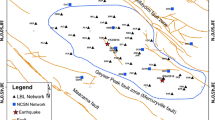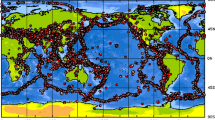Abstract
Nowcasting refers to the use of proxy data to estimate the current dynamic state of driven complex systems such as earthquakes, neural networks, or the financial markets. In previous papers, methods to nowcast earthquakes have been presented based on the natural time count of small earthquakes after the last large earthquake in a defined, seismically active geographic region. In this method, a large geographic region is identified in which a local region of interest is embedded. The primary assumption in the method is that the frequency-magnitude statistics of the local region are the same as the frequency-magnitude relation of the large region. The nowcasting technique relies on seismic catalogs that are complete in the sense that all events whose magnitude is larger than a completeness threshold have been detected. For this reason, the previous papers have been limited to nowcasting large earthquakes with magnitudes of approximately M7.5. In this article, we extend the nowcasting method to great global earthquakes of magnitudes as large as M9 by defining the surrounding large region as the entire earth. We then analyze the current hazard of a number of selected “local” regions and rank the regions in terms of current risk of great earthquakes. These great events also present significant hazards for generating mega-tsunamis as well as local damage due to intense shaking. We also perform a sensitivity analysis to establish the reliability of the nowcasts. One of our main results is that the eastern Aleutian Islands, site of the M8.6 earthquake of 1 April 1946, is currently the region most at current risk of a great earthquake larger than M8.0. We finish by presenting comments on the applicability of our methods for anticipating the occurrence of great destructive earthquakes and tsunamis.




Similar content being viewed by others
Notes
https://earthquake.usgs.gov/earthquakes/search/ (accessed 5/1/2018).
https://en.wikipedia.org/wiki/1952_Severo-Kurilsk_earthquake (accessed 6/1/2018).
https://en.wikipedia.org/wiki/Kamchatka_earthquakes (accessed 6/1/2018).
https://en.wikipedia.org/wiki/1923_Great_Kant%C5%8D_earthquake (accessed 6/1/2018).
https://en.wikipedia.org/wiki/1906_San_Francisco_earthquake (accessed 6/1/2018).
https://earthquake.usgs.gov/earthquakes/browse/largest-world.php (accessed 10/23/2018).
References
Banbura, M., Giannone, D., Modugno, M., & Reichlin, L. (2013). Chapter 4. Nowcasting and the real-time dataflow. In G. Elliot & A. Timmerman (Eds.), Handbook on economic forecasting (pp. 195–237). Amsterdam: Elsevier.
Banbura, M, Giannone, D., & Reichlin, L. (2011). Oxford handbook on economic forecasting. In M. P. Clements & D. F. Hendry (Eds.) Nowcasting, Working Papers ECARES 2010-021 (ULB – Universite Libre de Bruxelles).
Field, E. H. (2007). Overview of the working group for the development of regional earthquake likelihood models (RELM). Seismological Research Letters,78, 7–16.
Giannone, D., Reichlin, L., & Small, D. (2008). Nowcasting: The real-time informational content of acroeconomic data. Journal of Monetary Economics,55, 665–676. https://doi.org/10.1016/j.jmoneco.2008.05.010.
Gutenberg, B., & Richter, C. F. (1942). Earthquake magnitude, energy, intensity and acceleration. Bulletin of the Seismological Society of America,32, 163–191.
Holliday, J. R., Graves, W. R., Rundle, J. B., & Turcotte, D. L. (2016). Computing earthquake probabilities on global scales. Pure and Applied Geophysics,173, 739–748. https://doi.org/10.1007/s00024-014-0951-3. (published online before print 2014).
Holliday, J. R., Nanjo, K. Z., Tiampo, K. F., Rundle, J. B., & Turcotte, D. L. (2005). Earthquake forecasting and its verification. Nonlinear Proceedings of Geophysics,12, 965–977.
Holliday, J. R., Rundle, J. B., Turcotte, D. L., Klein, W., Tiampo, K. F., & Donnellan, A. (2006). Using earthquake intensities to forecast earthquake occurrence times. Physical Review Letters,97, 238501.
National Commission, Financial Crisis Inquiry Report, U.S Government Printing Office. (2011). ISBN 978-0-16-087983-8. https://www.gpo.gov/fdsys/pkg/GPO-FCIC/pdf/GPO-FCIC.pdf.
Rundle, J. B., Holliday, J. R., Graves, W. R., Turcotte, D. L., Tiampo, K. F., & Klein, W. (2012). Probabilities for large events in driven threshold systems. Physical Review E,86, 021106.
Rundle, J. B., Luginbuhl, M., Giguere, A., & Turcotte, D. L. (2018). Natural time, nowcasting and the physics of earthquakes: Estimation of seismic risk to global megacities. Pure and Applied Geophysics,175, 647–660.
Rundle, J. B., Turcotte, D. L., Donnellan, A., Grant-Ludwig, L., Luginbuhl, M., & Gong, G. (2016). Nowcasting earthquakes. Earth and Space Science,3, 480–486. https://doi.org/10.1002/2016EA000185.
Rundle, J. B., Turcotte, D. L., Sammis, C., Klein, W., & Shcherbakov, R. (2003). Statistical physics approach to understanding the multiscale dynamics of earthquake fault systems. Reviews of Geophysics and Space Physics,41(4), 15. https://doi.org/10.1029/2003rg000135.
Sarlis, N. V., Skordas, E. S., Varotsos, P. A., Ramiriez-Rojas, A., & Flores-Marquez, E. L. (2018). Natural time analysis: On the deadly Mexico M8.2 earthquake on 7 September 2017. Physica A,506, 625–634.
Scholz, C. H. (1990). The mechanics of earthquakes and faulting. Cambridge: Cambridge University Press.
Sornette, D., & Knopoff, L. (1997). The paradox of the expected time until the next earthquake. Bulletin of the Seismological Society of America,87, 789–798.
Varotsos, P. A., Sarlis, N. V., & Skordas, E. S. (2011). Natural time analysis: The new view of time. Berlin: Springer.
Varotsos, P. A., Sarlis, N. V., Tanaka, H. K., & Skordas, E. S. (2005). Some properties of the entropy in natural time. Physical Review E,71, 032102.
Acknowledgements
Research by JBR and ML was supported under NASA grant NNX12AM22G to the University of California, Davis. We thank R. Bilham for suggesting aspects of this approach to the nowcasting problem. Portions of the research were carried out by AD at the Jet Propulsion Laboratory, California Institute of Technology, under a contract with the National Aeronautics and Space Administration. None of the authors have identified financial conflicts of interest. We thank colleagues including Louise Kellogg (UC Davis), Jay Parker (JPL), and Lisa Grant (UC Irvine) for helpful discussions.
Author information
Authors and Affiliations
Corresponding author
Rights and permissions
About this article
Cite this article
Rundle, J.B., Luginbuhl, M., Khapikova, P. et al. Nowcasting Great Global Earthquake and Tsunami Sources. Pure Appl. Geophys. 177, 359–368 (2020). https://doi.org/10.1007/s00024-018-2039-y
Received:
Revised:
Accepted:
Published:
Issue Date:
DOI: https://doi.org/10.1007/s00024-018-2039-y





